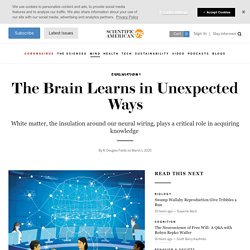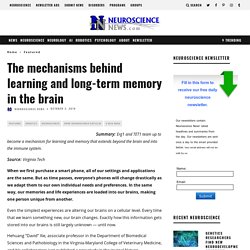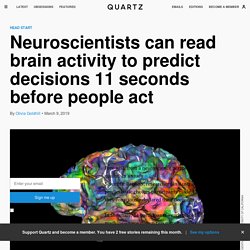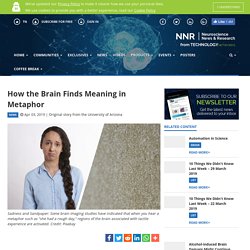

The human brain builds structures in 11 dimensions, discover scientists. The brain continues to surprise us with its magnificent complexity.

Groundbreaking research that combines neuroscience with math tells us that our brain creates neural structures with up to 11 dimensions when it processes information. By "dimensions," they mean abstract mathematical spaces, not other physical realms. Still, the researchers "found a world that we had never imagined," said Henry Markram, director of the Blue Brain Project, which made the discovery.
The goal of the Blue Brain Project, which is based in Switzerland, is to digitally create a “biologically detailed” simulation of the human brain. Le Cerveau - Passe-science #30. The Brain Learns in Unexpected Ways. Our concepts of how the two and a half pounds of flabby flesh between our ears accomplish learning date to Ivan Pavlov’s classic experiments, where he found that dogs could learn to salivate at the sound of a bell.

In 1949 psychologist Donald Hebb adapted Pavlov’s “associative learning rule” to explain how brain cells might acquire knowledge. Hebb proposed that when two neurons fire together, sending off impulses simultaneously, the connections between them—the synapses—grow stronger. When this happens, learning has taken place. In the dogs’ case, it would mean the brain now knows that the sound of a bell is followed immediately by the presence of food.
This idea gave rise to an oft-quoted axiom: “Synapses that fire together wire together.” The theory proved sound, and the molecular details of how synapses change during learning have been described in detail. (1) Le Cerveau - Passe-science #30. Thermodynamic Theory of the Brain Aims To Understand Consciousness. Consciousness is one of the brain’s most enigmatic mysteries.

A new theory, inspired by thermodynamics, takes a high-level perspective of how neural networks in the brain transiently organize to give rise to memories, thought and consciousness.The key to awareness is the ebb and flow of energy: when neurons functionally tag together to support information processing, their activity patterns synchronize like ocean waves.
This process is inherently guided by thermodynamic principles, which – like an invisible hand – promotes neural connections that favors conscious awareness. Disruptions in this process breaks down communication between neural networks, giving rise to neurological disorders such as epilepsy, autism or schizophrenia. 'Waves' of fluid clear the brain of toxins during sleep, say researchers. Evidence has been mounting that one of the major functions of sleep is to clear out metabolic waste products like beta-amyloids and tau proteins.These waste products tend to accumulate in the brains of Alzheimer's patients, implying that they play some part in neurodegenerative diseases.Now, researchers from Boston University have discovered that these toxic byproducts are flushed out in waves by cerebrospinal fluid during the slow-wave sleep phase.

The function of sleep has been something of a mystery for a long time. Nearly every creature in the animal kingdom sleeps in one way or another, indicating that it's a highly important function for survival, even if lying around and having anxiety dreams doesn't really seem all that productive. But new research published in the journal Science may have just uncovered what's really going on in our brains while we dream about being late for an exam because our teeth fell out.
Brain waste Neurons take up a lot of energy. Washing away the waste. Neuroscience Readies for a Showdown Over Consciousness Ideas. Some problems in science are so hard, we don’t really know what meaningful questions to ask about them — or whether they are even truly solvable by science. Consciousness is one of those: Some researchers think it is an illusion; others say it pervades everything.
Some hope to see it reduced to the underlying biology of neurons firing; others say that it is an irreducibly holistic phenomenon. The mechanisms behind learning and long-term memory in the brain. Summary: Erg1 and TET1 team up to become a mechanism for learning and memory that extends beyond the brain and into the immune system.

Source: Virginia Tech When we first purchase a smart phone, all of our settings and applications are the same. But as time passes, everyone’s phones will change drastically as we adapt them to our own individual needs and preferences. In the same way, our memories and life experiences are loaded into our brains, making one person unique from another.
Even the simplest experiences are altering our brains on a cellular level. How our brain remembers the order of events. Summary: A new theory and model helps explain how entorhinal time ramping cells produce hippocampal time cells.

The hippocampal cells allow for memory association between places and people to help recall event sequences. Source: University of Warwick For centuries understanding how the order of events is stored in memory has been a mystery. However, researchers from the Department of Computer Science at the University of Warwick have worked out how the order of events in memory could be stored and later recalled in the hippocampal memory system in the brain. In the new research, a theory and model was developed of how entorhinal time ramping cells produce hippocampal time cells which can be associated with places and people to help remember the sequence in which the people and places occurred during the remembered episode.
The theory demonstrates how we can remember what happened to us during the day in the correct order, and how we can provide an eye witness memory for a series of events. Neuroscientists read unconscious brain activity to predict decisions. Free will, from a neuroscience perspective, can look like quite quaint.

In a study published this week in the journal Scientific Reports, researchers in Australia were able to predict basic choices participants made 11 seconds before they consciously declared their decisions. The science of emotions: Jaak Panksepp at TEDxRainier. Memory formation depends on both synapse-specific modifications of synaptic strength and cell-specific increases in excitability. Facebook. How the Brain Finds Meaning in Metaphor. Sadness and Sandpaper: Some brain imaging studies have indicated that when you hear a metaphor such as "she had a rough day," regions of the brain associated with tactile experience are activated.

Credit: Pixabay You can grasp a hand. You can also grasp a concept. One is literal. One is metaphorical. Part 1: How To Be An Adult— Kegan’s Theory of Adult Development. Ever wondered what it means to be an adult?

I’m not talking about buying guest towels or renters insurance. I’m talking about how we ought to be developing in adulthood. How should we be perceiving and engaging with the world? Or handling conflict and interacting with the people around us? With children it’s easy. Capital - How to master new skills with ‘deliberate practice’ The amount of time you spend working on something does not equal the quality of the output.

Jogging the same routes, for instance, clocking up similar times every weekend will never transform you into a world-class athlete no matter how long you keep at it. Some of us strive to excel, but for most the thought of committing to even more training is daunting. So what if self-improvement did not require such a huge investment of time? Are there special qualities that people who strive for the top possess that allow them to rise above the rest?
BBC Capital asked a gold-medal winning Olympic coach, a record-holding football manager and a super learner. Stop repeating mistakes. Do you say “sorry” too much? What to say instead. Why smarter people choke under pressure. A recent study examined how goal-setting interacts with performance among people of varying intellectual capabilities. People with higher general mental abilities appear to perform worse when being directly measured along the lines of performance. Interestingly, these individuals' performance greatly improves when they were encouraged to simply do their best. Smart people are more likely to choke in high-pressure situations, but interestingly this disadvantage seems to vanish when goals are framed strategically. That's the takeaway of a study recently published in the Journal of Applied Psychology.
It suggests an ironic reason for why people with high general mental ability (GMA) often become mentally overwhelmed in complex, dynamic working environments: Their strong mental capacity leaves them vulnerable to performance anxieties and intrusive thoughts. The researchers hypothesized that reframing goals for these individuals might change performance. The Origin of Consciousness – How Unaware Things Became Aware. Why we worry: Understanding anxiety and how to help it.
Scientists Have Mapped Where People Feel Emotions in Their Bodies. Neuroticism Could Lead to Depression, Says Largest-ever Genetic Analysis. Neuroscientists Say They've Identified The Unique Brain Patterns of Consciousness. Editing Consciousness: How Bereaved People Control Their Thoughts without Knowing It. A control process (i.e. selective attention) is used by avoidant grievers to block mental representations (i.e. thoughts of the deceased loved one) from entering consciousness (yellow section).
When this is happening avoidant grievers are suppressing (yellow section) this suppression likely exhausts energy and ultimately leads to the mental representations breaking through attempted control and reaching consciousness (red section). Contrasting avoidant grievers those with a less avoidant style simply focus on what is in front of them without trying to monitor their internal mental state as much (blue section). Credit: Noam Schneck/Columbia Engineering People who are grieving a major loss, such as the death of a spouse or a child, use different coping mechanisms to carry on with their lives.
Psychologists have been able to track different approaches, which can reflect different clinical outcomes. New findings on brain functional connectivity provide insights into psychological resilience. New neuroimaging research in Neuropsychologia has found some links between a person’s innate resilience to the struggles of life and functional connections within the brain. “Psychological resilience plays an important role in determining whether or not an individual develops post-traumatic disorders after experiencing severe traumatic events. Nearly 200 cognitive biases rule our everyday thinking.
Nearly 200 cognitive biases affect our decision-making. The sheer amount of biases should teach us humility.And we should recognize the essential role they play in life, as well. Aside from mythical spiritual figures and biblical kings, humans are not objective in how they react to the world. As much as we would like to be fair and impartial about how we deal with the situations that arise on a daily basis, we process them through a complex series of internal biases before deciding how to react. Even the most self-conscious of us cannot escape the full spectrum of internal prejudices. Brain biases can quickly become a hall of mirrors.
The Peter Baumann approach This video file cannot be played. Originally a pioneer of German electronic dance music, Peter Baumann now devotes himself to exploring the science and philosophy of the human experience. There is nothing that is not a bias. Does Interpretation Training Grow Your Brain? Video. Learning New Vocabulary During Deep Sleep. Nearly 200 cognitive biases that rule out everyday thinking. Nearly 200 cognitive biases affect our decision-making.The codex groups the biases based on 4 major "problems".The sheer amount of biases teaches us "humility," says one of the Codex's creators. Perhaps aside from mythical spiritual figures, humans are not objective in how they react to the world. Why forgetting may make your mind more efficient. Unlock Your Brain’s True Potential With These Online Neuroscience Courses. Essential Secrets of Psychotherapy: Why We Worry (and what we can do about it) Why we worry: Understanding anxiety and how to help it. Navigating our Thoughts: Fundamental Principles of Thinking.
Sleep Deprivation Effective as an Anti-Depressant for Nearly Half of Depressed Patients. Sleep deprivation – typically administered in controlled, inpatient settings – rapidly reduces symptoms of depression in roughly half of depression patients, according the first meta-analysis on the subject in nearly 30 years, from researchers at the Perelman School of Medicine at the University of Pennsylvania. Partial sleep deprivation (sleep for three to four hours followed by forced wakefulness for 20-21 hours) was equally as effective as total sleep deprivation (being deprived of sleep for 36 hours), and medication did not appear to significantly influence these results. The results are published today in the Journal of Clinical Psychiatry.
Study of advanced Buddhist meditators suggests inducing near-death experiences can be learned and perfected. Key Molecule Responsible for Learning and Memory Discovered. Unlike old dogs, old adults can indeed learn new tricks thanks to a protein molecule called netrin. Netrin is known to help set up the healthy nervous system in an infant's developing brain by directing brain cells to make appropriate connections with other brain cells.
Astrocytes Show Unexpected Role in Brain Plasticity. Astrocytes are the main cell type in the brain producing Chrdl1. A Neural Code That Predicts Behavior. You Won't Believe Your Eyes. A first lesson in meta-rationality. Is everything you think you know about depression wrong? Study suggests physical changes to the brain due to learning happen differently than thought. Does Your Language Influence How You Think? Neurons that Fire Together, Wire Together? Not Always. People who see patterns where none exist are more receptive to pseudo-profound bullshit. Key Molecule Responsible for Learning and Memory Discovered. The nostalgia economy: Your memories are idealized versions of a past that never existed.
Facebook. Neuroscientists Have Found a Crucial Difference That Makes Human Brain Cells Unique. Different cognitive effects of dextromethorphan and psilocybin observed in new study. An altered 'perception of illusory control' helps explain why some people are more superstitious than others. Three people had their brains wired together so they could play Tetris. Brain Activity Has Been Recorded as Much as 10 Minutes After Death. What if Consciousness is Not What Drives the Human Mind? The nostalgia economy: Your memories are idealized versions of a past that never existed. Scientists Identify a New Kind of Human Brain Cell.
Openness to Experience linked to reduced cortical thickness in several brain regions. When you can't afford to make a mistake, this’ll keep you sharp. These Crucial Brain Functions Are Not Affected by Gender or Sex, Study Reveals. 4 Strategies for Overcoming Distraction. Leg Exercise is Critical to Brain and Nervous System Health. Scientists Discover Fundamental Rule of Brain Plasticity. Earth - The strange link between the human mind and quantum physics.
Our memory comes from an ancient virus, neuroscientists say. Young Brain Cells Silence Old Ones to Quash Anxiety. "Traveling" Brain Waves May Be Critical for Cognition. Our memory comes from an ancient virus, neuroscientists say. Win-Stay-Lose-Switch, Serotonin Speeds Rate of Long-term Learning. New Scientist - Publications. Neuroprotective Molecule Could Improve Memory and Cognition. Leg Exercise is Critical to Brain and Nervous System Health. Best Friends Really Do Share Brain Patterns, Neuroscientists Reveal. How social isolation transforms the brain. Light-Triggered Genes Reveal the Hidden Workings of Memory. Scientists Sucked A Memory Out of a Snail and Stuck it in Another Snail. Neuroscience shows how dance music and meditation have similar effects. Physicists overturn a 100-year-old assumption on how brains work. A fantastic chart of cognitive biases:… Ebbinghaus et la courbe de l'oubli pour bien mémoriser.
How your brain's viewpoint shapes your personality. New Brain Maps With Unmatched Detail May Change Neuroscience. Allen Brain Atlas: Mouse Connectivity. Creativity is another form of logic. Old people can produce as many new brain cells as teenagers. Mind-Controlled Mice Navigate Mazes, No Longer Crave Food. Panpsychism: The idea that everything from spoons to stones are conscious is gaining academic credibility. Creating hallucinations without drugs is surprisingly easy. Nihms479995. The brain learns completely differently than we've assumed since the 20th century.
Lana Awad is engineering the neuro-tech that will transform humanity. Study your brain structure with this... - The NeuroScientist. Memories Can Be Decoded from Brain Waves During Sleep. <font color="#00d0ff">Click to Listen</font> — After On. <font color="#00d0ff">Click to Listen</font> — After On. Reached Via a Mind-Reading Device, Deeply Paralyzed Patients Say They Want to Live. Magnetic Brain Stimulation Alters Negative Emotion Perception. Magnetic Brain Stimulation Alters Negative Emotion Perception.
AI Just Learned How to Boost the Brain's Memory. Facebook.